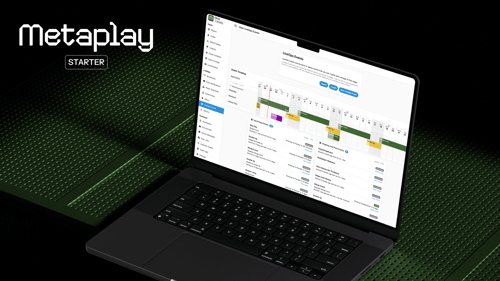
How to Choose the Right Backend for Your Mobile Game
.jpeg)
Chris Wilson •
The right backend technology can propel your mobile game's growth. But with a wide range of BaaS providers in the market, how do you choose the right one for your game? We break down 4 key considerations.
Every game studio faces the same dilemma: should you buy your backend technology from an external vendor, or invest in building your own backend tech in-house? For most developers, the latter is not a viable option (we’ll get into that later on).
But with numerous third party backend services to choose from, it can be challenging to identify the ideal option for your game. It’s a crucial decision in a young studio’s life - needing to migrate to a different backend vendor later on will likely be a major headache.
That’s why we’ve written this article - to help you understand the key considerations when choosing a backend technology. Let’s get started.
What is a mobile game backend?
A mobile game backend refers to the server-side infrastructure and services that support a game’s core gameplay, and enable an array of crucial functionalities for developers to deploy.
In essence, the backend is the backbone of every mobile game, the hidden powerhouse that fuels a game's daily functionality and online features.
Think: multiplayer capabilities, cheat-proof logic, security, real-time updates, social interactions, LiveOps management, leaderboards, achievements, cloud storage, and more.
The backend also handles all the user management and authentication, making sure players have secure access to the game's features. It takes care of data storage and synchronization, allowing players to seamlessly switch devices without losing their hard-earned progress.
Plus, it's the engine that keeps players connected, enabling real-time communication between them, as well as facilitating communication between developers and the players - for instance through push notifications and in-app messaging.
Mobile game backends also provide easy integration of third party data platforms - or offer native data analytics - to give developers invaluable insights into player behavior, helping them make smart decisions and deliver personalized experiences.
In short, the backend is the secret sauce that helps game developers create those immersive, connected, reliable, and consistently engaging experiences that all top-tier games-as-a-service require.

Can you build your own backend tech?
Yes - most of the games who sit in the top-grossing charts use backend technologies that have been developed internally.
The pros of building your own backend tech
There are several benefits of building your own backend:
1. Ownership and control
When you build a backend in-house, your tech and tools will only ever be yours. You’ll always be in full control, and won’t have to rely on third-party updates in order for your game to run effectively. What’s more, your backend will become part of your studio’s core IP - which could then become a point of interest to potential investors later on down the line.
2. Complete customization
When you build backend technology in-house, you can tailor your backend to meet the specific needs of your game. You won’t be limited by the capabilities and generic functions of a third-party backend, which is a big plus as you grow and need to build more complex features and functionalities. Having said this, third party backend solutions like Metaplay offer full customization and flexibility.
3. NO THIRD-PARTY DEPENDENCIES
When an in-house team of engineers is responsible for your backend technology, it can be easier to communicate and you don’t need to rely on a third party for your game’s functionality.
The drawbacks of building your own backend tech
1. IT'S EXPENSIVE
To build and maintain a robust backend infrastructure, you need to hire a team of experienced engineers. A five-person team is usually the minimum, and that costs a lot of money: money that many studios can’t afford to spend early on.
2. IT'S SLOW
Building a team of top engineers is a time-consuming process. It can take months just to start finding the right people, then you need to ensure you have the right appeal to bring them to your studio, and of course, get them all working together to start creating your tech. And only then does the real work begin.
With all that said, it’s easy to see why it often takes years to build anything close to a fully-functioning backend. For most mobile game developers, speed and time to market is crucial - and therefore it makes little sense to dedicate so much time to backend development.
3. IT'S A LONG-TERM RESOURCE BURDEN
When you build a backend, it’s not a case of launching it and setting off into the sunset. A backend requires constant maintenance and work. Most of the top mobile games now operate as live services, with the constant need to add new features and functionalities. A game’s backend needs to be constantly evolving to support its innovation and growth.
It also needs to be able to scale alongside the game to provide bug-free gameplay at scale, and provide all the functionalities a developer requires for a game with a million users, and then 10 million, and then 100 million.
In short - a team of engineers needs to be responsible for this over the long-run - which represents a significant resource burden. Especially given the alternative, which is using a battle-tested external backend provider that takes care of all of this work for you.
How to choose the right backend-as-a-service
Using a backend-as-a-service will enable you to save on the time and cash investment of building and maintaining an in-house tech stack.
However, not all backend providers were created equal, and there are numerous options on the market with different functionalities.
Some basic questions to ask yourself are:
-
What engine (Unity or Unreal, for example) are you creating your game on, and does the backend tech support this?
-
What is your budget and does the backend provider’s pricing align with it?
-
Is a specific functionality you need, let’s say LiveOps management or mass multiplayer game modes, supported by the backend provider?
In addition to some of these elementary questions, here are some other crucial things to consider:
1. Does the backend provide a tech upgrade path?
Games evolve, and the most successful games innovate - but not all backend services provide the functionalities to support this.
If you’re launching a game with the vision to get it into the top grossing charts, then you need to choose a backend that provides as much flexibility and extensibility as possible.
In other words, when the time comes to innovate on your game design and deploy exciting new features or gameplay mechanics, will your backend provider allow you to do so seamlessly?
Most of the traditional backend services provide a limited array of off-the-shelf functionalities, which are enough to launch a solid game. But, further down the line, these limitations can ultimately stifle the innovation needed to eventually break into the top charts.
Before choosing your backend solution, think about your long-term ambitions and make sure you clarify with their team the extent of the tech’s flexibility and extensibility.
2. Does the backend provider give you full control over your game and your data?
When you use a third party service for your backend technology, it’s crucial that you have control and ownership of your data. Without this, you risk losing everything, and your game ceasing to operate, in the event that the company which provides your backend tech closes down.
Metaplay, for instance, ships as source code deployed into your own cloud - giving you full control over your data. This means you never need to worry about your game not running should anything ever happen to Metaplay.
3. Does the backend provider offer top-tier support?
When choosing a backend-as-a-service, make sure it has a comprehensive knowledge center full of documentation on how to use the product.
Also check with their sales team about the kind of communication and support they offer: for instance, will you be added to a Slack channel where you can communicate directly with the support team?
4. Is the backend battle-tested?
You want your backend-as-a-service provider to be reliable and experienced, with battle-tested technology and functionality to support your game from day 1 all the way to the top.
Look for case studies and testimonials from gaming companies who’ve used them - if successful developers are vouching for them, it’s a good sign.
Choosing a backend for your mobile game: Final takeaways
Choosing the right backend provider or backend-as-a-service (BaaS) for your mobile game is a crucial decision that can significantly impact a studio’s success.
Consider your game's specific needs and thoroughly evaluate providers based on factors such as scalability, compatibility, functionality, security, and support, in order to make an informed choice. Don’t hesitate to reach out to the sales teams of the various companies out there to ensure you get a deep understanding of their offerings.
Also, explore case studies and testimonials to learn from the experiences of other developers - you can even get in touch with those customers directly to ask some questions.
You really want to leave no stone unturned - choosing the wrong backend solution will create major headaches further down the line, for instance needing to migrate to a different backend service after “outgrowing” the functionalities provided by your existing partner.
With the right backend in place, you can unlock a world of possibilities, enhance player engagement, and create an exceptional gaming experience that keeps players coming back over the long-term, scaling your studio to new heights.



